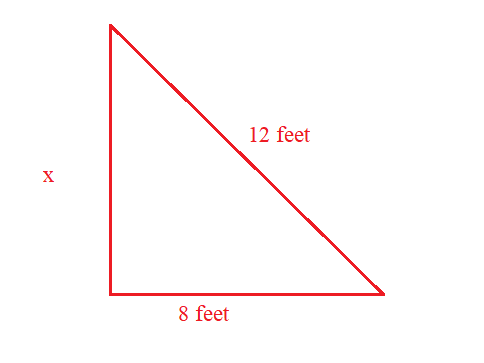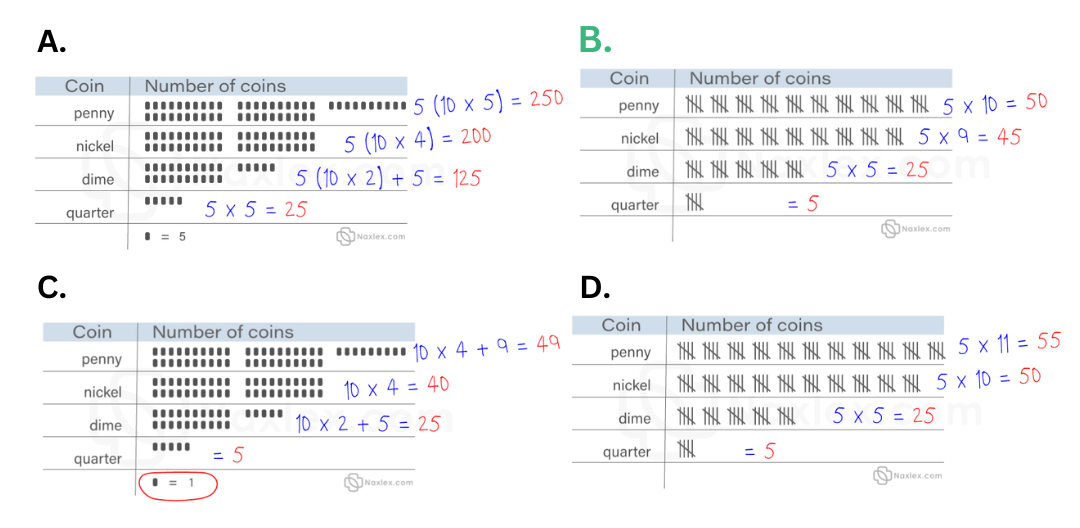An athlete runs 4 miles in 28 minutes and then changes their pace to run the next 4 miles in 32 minutes. Overall, what is the average time in minutes it takes the athlete to run 1 mile?
7 minutes
8 minutes
7.5 minutes
8.5 minutes
Correct Answer : C
to find the average time the athlete runs in 1 mile, find total time divided by total distance covered.
Total distance=4+4=8 miles
Total time=28+32 =60 minutes
From the above, the athlete runs 8 miles in 60 minutes, so the athlete will take how minutes to cover 1 mile.

So, the athlete covers 1 mile in 7.5 minutes.
TEAS 7 Exam Quiz Bank
HESI A2 Exam Quiz Bank
Find More Questions 📚
Teas 7 Questions: We got the latest updated TEAS 7 questions
100% Money Refund: 100% money back guarantee if you take our full
assessment pass with 80% and fail the actual exam.
Live Tutoring: Fully customized live tutoring lessons.
Guaranteed A Grade: All students who use our services pass with 90%
guarantee.
Related Questions
Correct Answer is A
Explanation
to change L to mL we use the following options of interconversions:

Or

Since we are needed to change L to mL, use the second option.

Thus, a bucket can hold 3000 mL which is equal to 3 L.
Correct Answer is D
Explanation
: we are to find the selling price of the sweater after subtracting the mark off price.
Mark off value=mark off rate*original price
Mark of value=25%*$87
We convert 25% into a fraction, which become 25/100=0.25. Then
Mark of value=0.25*$87=$21.75
The selling price of the sweater will be the original price less the mark off value. Then,

Thus, the approximate selling price of the sweater is $65.
Correct Answer is B
Explanation
we are asked to find the largest value from the options given. To solve this problem, we need to convert all the given values into fraction. Then find the least common denominator for all fractions, which we will use to multiply each fraction and make a comparison.
34÷96=
3/8=3/8
0.372=372/1000
37%=37/100
Now, we need to find the least common denominator of 48, 8, 1000, and 100, which is 6000. We multiply each fraction by 6000 as follows:
17/48*6000=2125
3/8*6000=2250
372/1000*6000=2232
37/100*6000=2220
From the above calculations, arranging the fraction from the largest to the smallest in order is: 3/8, 372/1000,37/100, and 17/48. Thus, the greatest value is 3/8.
Correct Answer is B
Explanation
here we use the US customary system to convert between yards and feet. We use the conversion 1 yard =3 feet. Then, 6 yards to ft is found as

Thus, 6 yards is equal to 18 ft.
Correct Answer is C
Explanation
To simplify the expression:
12+3×4−1+23
Step 1: Follow the order of operations (BODMAS)
Multiplication first:
3×4=12
23 = 2×2×2=8
Now the expression becomes:
12+12−1+8
Step 2: Perform addition and subtraction from left to right
- 12+12=24
- 24−1=23
- 23+8=31
The correct answer is 31.
Correct Answer is B
Explanation
We are told to find the area of the pizza given its diameter. The pizza is in circular form, and its area is found as:

However, we are not given r, which is the radius of the circle. But we can find it from the given diameter as

Substituting r=8 in the equation of the area of a circle

Thus, the area of the pizza is 64  in2.
in2.
NOTE:  (Pi) remains as a symbol because values of Pi can vary from 22/7 to 3.1415 to 3.14 and so forth.
(Pi) remains as a symbol because values of Pi can vary from 22/7 to 3.1415 to 3.14 and so forth.
Correct Answer is A
Explanation
The initial step is to convert the decimal numbers into fractions.
4.4 becomes 44/10
4.25 becomes 425/100
Thus, the set of fractions is 9/2, 44/10, 10/3, 425/100. The least common denominator for 2, 10, 3, and 100 is 300, which we use to compare each options given.
9/2*300=1350
44/10*300=1320
10/3*300=1000
425/100*300=1275
From the above, 1350 is the greatest value which corresponds to 9/2. Thus, 9/2 is the greatest value of all the choices given.
Correct Answer is D
Explanation
The length of the unknown side of the rectangle can be found by using the Pythagoras theorem. We label the triangle from the given data as shown below
Let the unknown length be x.

Applying the Pythagoras theorem, the value of x is found as:
\(a ^2 +b ^2 =c ^2\)


The unknown length of the triangle is approximately 8.9 feet.
Correct Answer is B
Explanation
In this scenario, we use the given scale in the charts to find the number of each coin and selected the right number of coins the student collected. The second options shows that the child collected 50 pennies, 45 nickels, 25 dimes, and 5 quarters.

Correct Answer is D
Explanation
Correlation of two variables falls into:
Positive correlation: an increase in one variable causes another variable to increase
Negative correlation: an increase in one variable causes another one to decrease
No correlation: a change in one variable does not cause any response in another variable.
From the given choices
Option a is no correlation
Option b is a negative correlation
Option c is a negative correlation
Option d is a positive correlation
This question was extracted from the actual TEAS Exam. Ace your TEAS exam with the actual TEAS 7 questions, Start your journey with us today
Visit Naxlex, the Most Trusted TEAS TEST Platform With Guaranteed Pass of 90%.
Money back guarantee if you use our service and fail the actual exam. Option of personalised live tutor on your area of weakness.
